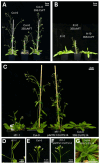Assessing Functional Conservation Amongst FT- and TFL1-like Genes in Globe Artichoke
- PMID: 40364391
- PMCID: PMC12073138
- DOI: 10.3390/plants14091364
Assessing Functional Conservation Amongst FT- and TFL1-like Genes in Globe Artichoke
Abstract
Globe artichoke [Cynara cardunculus var. scolymus (L.)] is a perennial composite cultivated for its immature inflorescences. Over time, the market for growers has steadily shifted away from vegetatively propagated varieties and towards seed-propagated hybrids. Since the latter tend to produce relatively late in the season, advancing the moment of flowering remains a major objective for breeders, who can benefit from insight gained into the genetic architecture of this trait. In plants, the timing of flowering is strongly regulated at the genetic level to ensure reproductive success. Genetic studies in model and non-model species have identified gene families playing crucial roles in flowering time control. One of these is the phosphatidylethanolamine-binding protein (PEBP) family, a conserved group of genes that, in plants, not only regulate the vegetative-to-reproductive phase transition, but also the development of inflorescences. In this work, we identified seven PEBP family members in the globe artichoke genome, belonging to three major clades: MOTHER OF FT AND TFL1 (MFT)-like, TERMINAL FLOWER 1 (TFL1)-like, and FLOWERING LOCUS T (FT)-like. Our results further show that CcFT expression is upregulated after the floral transition and partially complements the ft-10 mutant, whilst CcTFL1 is expressed in the shoot apex and developing inflorescences and complements the tfl1-1 mutant. These results suggest that the flowering-suppressing function of CcTFL1 is conserved in globe artichoke whereas conservation of the floral promoting function of CcFT remains uncertain.
Keywords: FT; PEBP family; TFL1; bolting time; flowering; globe artichoke.
Conflict of interest statement
Authors Rick Berentsen and Peter Visser were employed by the company BASF’s vegetable seeds business. The remaining authors declare that the research was conducted in the absence of any commercial or financial relationships that could be construed as a potential conflict of interest.
Figures








References
-
- Scaglione D., Reyes-Chin-Wo S., Acquadro A., Froenicke L., Portis E., Beitel C., Tirone M., Mauro R., Lo Monaco A., Mauromicale G., et al. The genome sequence of the outbreeding globe artichokes constructed de novo incorporating a phase-aware low-pass sequencing strategy of F1 progeny. Sci. Rep. 2016;6:19427. doi: 10.1038/srep19427. - DOI - PMC - PubMed
-
- FAOSTAT FAOSTAT. Food and Agriculture Organization of the United Nations on 2022-01-28.2022. [(accessed on 9 March 2022)]. Available online: https://www.fao.org/faostat/
-
- Pignone D., Sonnante G. Wild artichokes of south Italy: Did the story begin here? Genet. Resour. Crop. Evol. 2004;51:577–580. doi: 10.1023/B:GRES.0000024786.01004.71. - DOI
-
- Elia A., Miccolis V. Relationships among 104 artichoke (Cynara scolymus L.) accessions using cluster analysis. Adv. Hortic. Sci. 1996;10:158–162.
LinkOut - more resources
Full Text Sources
Research Materials
Miscellaneous

